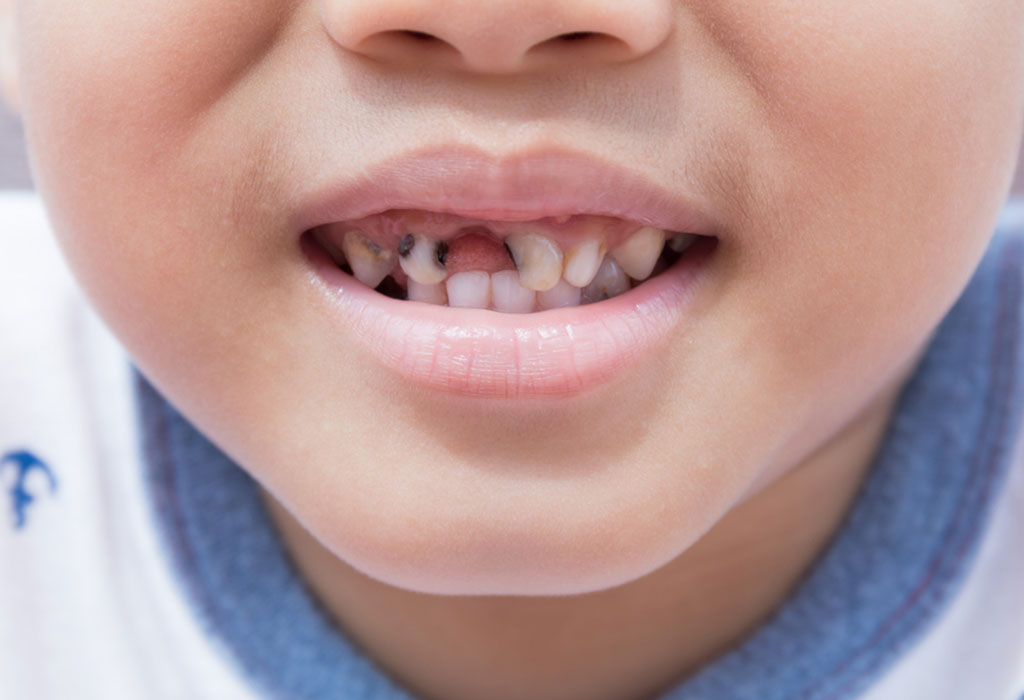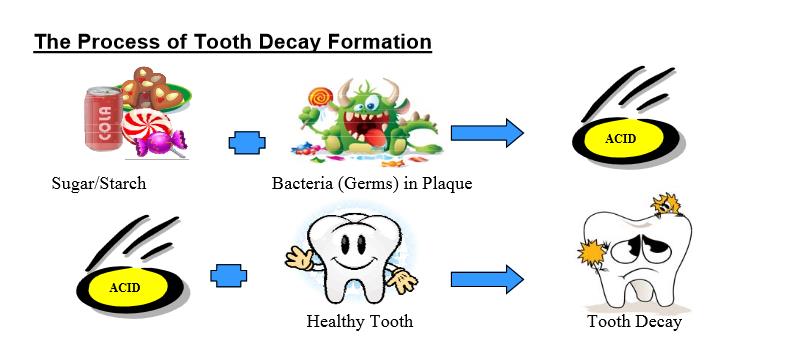
Fighting Tooth Decay in Children
February 19, 2020 ABC Children's Dentistry
Tooth decay in children (or cavities) is caused by bacteria in the mouth damaging the teeth. This bacteria is called plaque. It attaches itself to the tooth’s enamel and ultimately damages enamel as it eats away at the protective covering.
In this article, we will discuss what causes decay, as well as its symptoms and stages. Then, we will review which children are at risk for tooth decay, how it can be treated, and what to do to prevent tooth decay. Keep reading to learn how to fight tooth decay in children and how a combination of fluoride, sealants, and a good dentist can help.
Which Children Are at Risk for Tooth Decay?
All children are at risk for tooth decay if proper precautions are not taken. Children with poor oral hygiene are more likely to struggle with tooth decay. It’s important to practice good habits with your children such as routine tooth brushing and flossing and scheduling regular visits to the dentist.
Toddlers with the following risk factors are more likely to grapple with tooth decay:
- Those with lots of bacteria, which can cause cavities
- Children who eat too many sugars and carbohydrates
- Individuals who do not have fluoride in their available water supply
- Kids who experience dry mouth or a lack of saliva
- Those with deep grooves in their teeth, especially molars
- Children who sleep with a bottle
If your child has any of the above risk factors or doesn’t brush and floss regularly, they are at a higher risk for tooth decay. How do you know that your little one is suffering from tooth decay? Decay can be different in each child, but there are some signs and symptoms to look out for.
Check out our blog to find out about how Vitamin D helps prevent tooth decay.
What Are the Symptoms of Tooth Decay?
When a tooth is exposed to repeated acid attacks, enamel can be damaged. An early sign of decay is white spots. White spots may appear on the tooth where minerals have been lost. If the decay is caught at this point, it can be reversed with the help of a fluoride treatment from the dentist. However, if damage continues, the enamel will continue to grow weak and a cavity will develop. Cavities are permanent and cannot be reversed. Cavities must be treated by a dentist with fillings to prevent further decay.
Other signs of decay might include:
- Bad breath
- Dark brown or black spots on teeth
- Inflammation (i.e. red, swollen gums)
- Sensitivity to hot or cold foods
- Pain in and around the tooth
- Broken teeth
If you notice white spots that you believe might be tooth decay, it’s important to make an appointment to see your dentist right away. Then, the dentist can treat the tooth with fluoride, which can strengthen enamel and reverse the decay. Without early diagnosis and treatment, your child may need more serious procedures like fillings, root canals, or crowns down the line.
What Are the Stages of Tooth Decay?
There are different stages of tooth decay in children. Early decay is treatable by a dentist. In these cases, more serious procedures are avoided. Advanced tooth decay demands more involved procedures such as fillings or root canals. If decay progresses further without treatment, your child may even lose their tooth.
Stage 1: White Spots
During this stage, a dentist can still reverse decay by remineralizing teeth with a fluoride treatment.
Stage 2. Enamel Decay
This is the point when the tooth’s enamel begins to be eroded by the bacteria. At this point, it is likely that your child’s dentist will need to apply a filling to the damaged tooth.
Stage 3: Dentin Decay
At this stage, the pulp inside the tooth is exposed and begins to decay. The dentist will most likely need to perform a pulpectomy at this point.
A pulpectomy saves the damaged baby tooth by removing decaying and damaged pulp to allow the tooth to heal. However, a tooth at this stage will need a filling and, likely, a cap if it is to be saved.
Stage 4: Abscess
If left unchecked, a dental abscess forms. An abscess occurs when the damaged pulp becomes infected by bacteria. Infected pus cannot drain and, as a result, forms an abscess that causes red, swollen gums and pain. An abscess can even cause your child’s jaw to swell.
If you believe your child has an abscess, you should make an appointment with the dentist immediately. Your child likely needs antibiotics for the infection.
Can It Be Reversed?
Tooth decay can be stopped or reversed if discovered in time. Many dentists can apply fluoride and minerals to repair damaged enamel if decay has not yet caused cavities or damage to the tooth pulp. In some cases, enamel can even repair itself with minerals from the child’s saliva and the help of fluoride toothpaste.
If the decay is found at the “white spot” stage—and not once dark brown spots or more serious damage is visible—reversal is still possible. However, if the decay continues and more enamel is lost, the enamel will be too weak to resist cavities. Cavities, also known as dental caries, are permanent damage and need to be repaired with a filling by your dentist.
How Is Tooth Decay Treated?
Treatment options for tooth decay depend greatly on the stage at which the decay is discovered and dealt with. The following treatments are all viable options for tooth decay in children:
- Fluoride treatment – When decay is found at an early stage, remineralization with fluoride can treat and reverse decay.
- Dental filling – If decay reaches a stage where it is irreversible, the child needs a dental filling to stop the cavity-forming from getting worse.
- Pulpectomy – When the cavity is large and the pulp of the tooth is infected or exposed, your child needs to have the infected or damaged pulp removed followed by a filling or crown.
- Crown – If the damaged area is too large to be treated with a filling, your dentist may recommend a crown to cover the exposed hole.
- Antibiotics – If an abscess forms, your child may need antibiotics to treat their infection.
- Extraction – Sometimes extracting the damaged tooth is a good option. Usually, this is done when a primary tooth (also known as a baby tooth) would have been lost soon.
Why Wouldn’t the Dentist Just Extract the Damaged Tooth?
When tooth decay in children reaches the advanced decay stage, it requires treatment. Extraction is an option at this point, but may not be the best course of action. Here are some reasons your dentist might choose to treat the decaying tooth, rather than extract it:
- Baby teeth are the best way to guide permanent teeth into their proper position. When a primary tooth is lost, the remaining teeth help the incoming permanent tooth by guiding it to the appropriate place. If one is missing due to extraction, permanent teeth might not find their correct positions can cause problems in adulthood.
- There are risks with extraction. Common side effects include minor swelling, bleeding, and pain. However, there are more serious risks such as infection, as well. Germs can enter the wound left by the extracted tooth and cause infection.
- If decay is not advanced, it may be possible to reverse decay with fluoride treatments. When a filling is necessary, the tooth can still remain strong and healthy until it is time for natural loss.
- Finally, loss of certain teeth can cause children to have problems with speech, oral development issues, and adult teeth in the future.
How Can It Be Prevented?
We all agree that tooth decay should be avoided, but how? Here are some practical steps you can take to prevent tooth decay in your children:
- Teach children to practice good oral hygiene at an early age. Help them to develop healthy habits like brushing twice a day with fluoride toothpaste and flossing daily. Teach them how much toothpaste to use, how long to brush, and to be sure to brush back teeth well.
- Ensure your child is getting enough fluoride. While fluoride is present in bottled water and many city water sources, its levels are low. Children should use a toothpaste with fluoride and get fluoride polish treatments during routine cleanings at their dentist’s office. If your water is not fluoridated, your dentist or pediatrician can provide supplements.
- You may also choose to limit your child’s access to certain foods. Foods high in sugar, juices, and candy (especially sticky candy like gummy bears or fruit “roll-ups”) can damage tooth enamel and cause cavities. If you approve of these foods, consider having your child rinse their mouth or brush their teeth after eating.
Does My Toothpaste Need to Contain Fluoride?
Prior to 2014, the ADA (American Dental Association) advised switching to a fluoride toothpaste for children when they reached the age of two. This recommendation was based on fears about children under two ingesting a large quantity of fluoride by swallowing too much toothpaste.
However, the recommendation has since been updated. Now, the ADA recommends using a children’s toothpaste containing fluoride as soon as teeth appear. It is noted that care should still be taken with young children to ensure they do not consume too much toothpaste. An amount the size of a grain of rice is all that is needed for young children. In fact, even adults should avoid using more than a pea-sized amount of fluoride toothpaste.
Why the change? Because we now know that using toothpaste with fluoride regularly is the best way to prevent tooth decay in children like cavities.
One way to prevent a young child from accidentally swallowing fluoride toothpaste is to angle their head down so that any extra toothpaste exits the mouth. As long as you are using the correct amount of toothpaste, any small amounts swallowed shouldn’t cause trouble.
Nearing three years of age, your child should be able to spit out any extra toothpaste instead of swallowing it. Children should be instructed to do this and adults should continue to oversee toothbrushing while children are young.
How Can Sealants Help Fight Tooth Decay?
Dental sealants are a thin coating painted on the chewing surfaces of children’s teeth to prevent tooth decay or cavities. Most commonly, sealants are used on the back teeth: the molars and premolars. The painted-on liquid sealant sticks to pits and grooves on teeth, creating a layer of protection over the tooth’s enamel.
Sealants can prevent 80% of cavities within the first two years after application. They also continue to protect against 50% of cavities for the first four years. The Center for Disease Control and Prevention (CDC) says sealants can remain in the mouth for up to nine years with proper dental care.
Primary teeth, also known as baby teeth, can be sealed. However, the child needs to be old enough to tolerate the procedure. Though the application is painless, it is important for the child to be able to sit with their mouth open and not move for a few minutes. Most dentists recommend applying sealants after the child has all their molars or premolars. Usually, treatment for younger teeth is reserved for those with an increased risk of decay.
Fighting tooth decay in children requires a combination of approaches and team effort. In order to preserve your child’s dental health, you must take precautions.
First, you should practice good oral hygiene: teach your child proper brushing and flossing technique and ensure that brushing with toothpaste that contains fluoride becomes a daily habit.
Secondly, parents should take their children to the dentist for routine check-ups and cleanings—complete with fluoride treatments and x-rays to ensure there are no signs of decay.
Finally, signs of decay should be addressed quickly to avoid serious treatments and outcomes that can affect permanent teeth in the future. If you have more questions about avoiding decay or treating signs of decay in children, consider making an appointment with your dentist to discuss your concerns. After all, your child’s dentist is an expert at fighting tooth decay.







